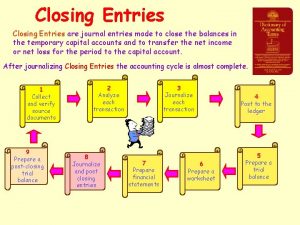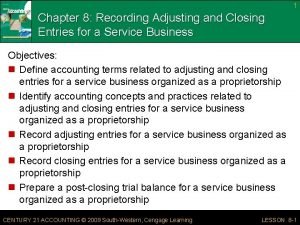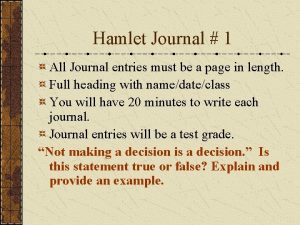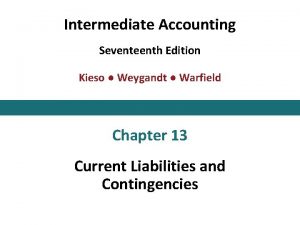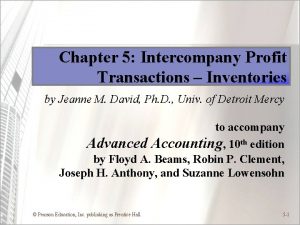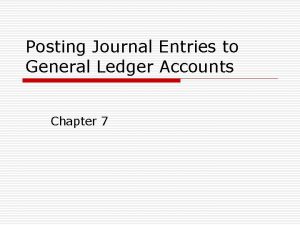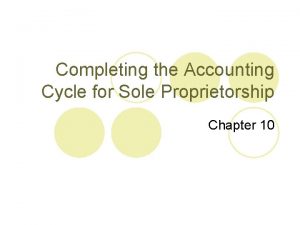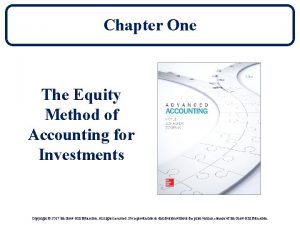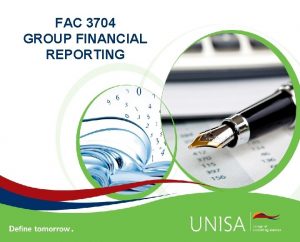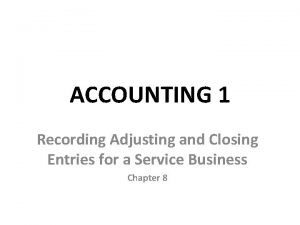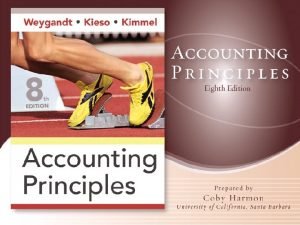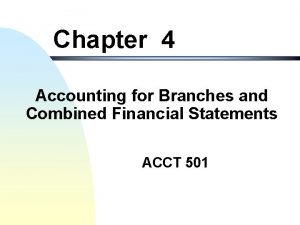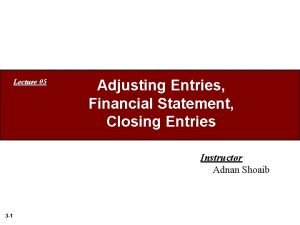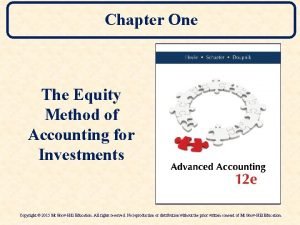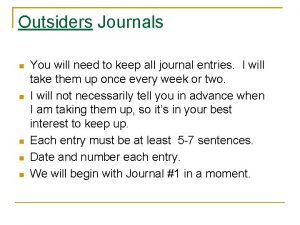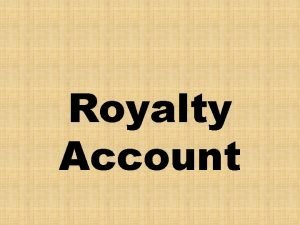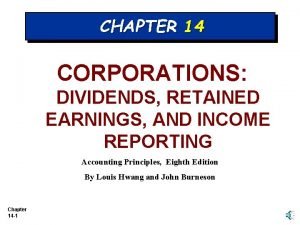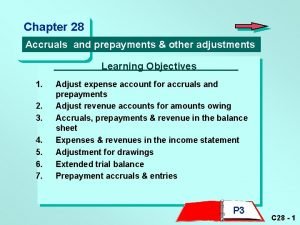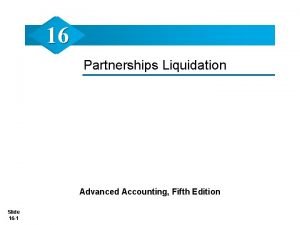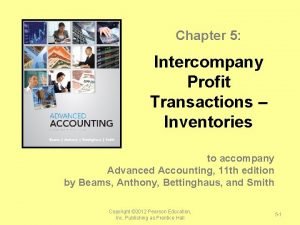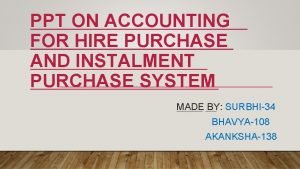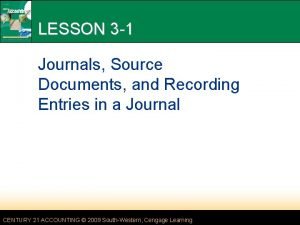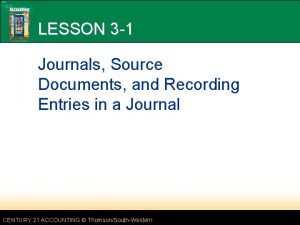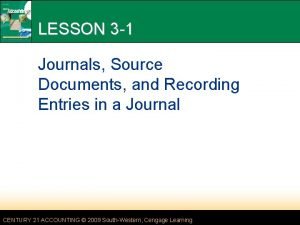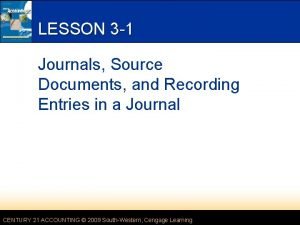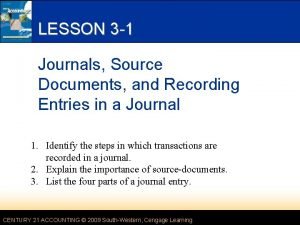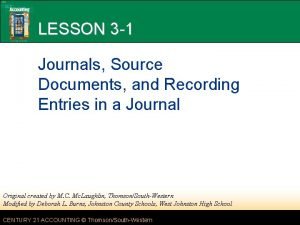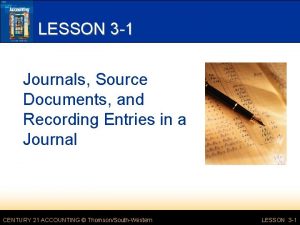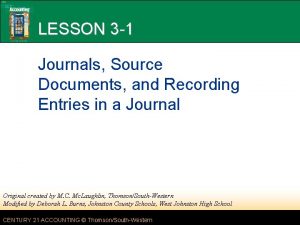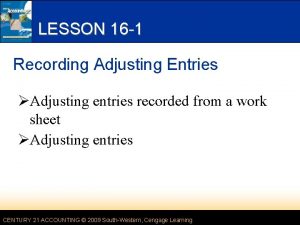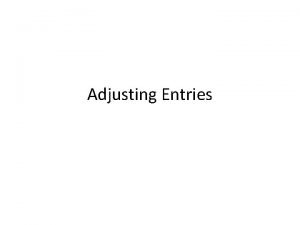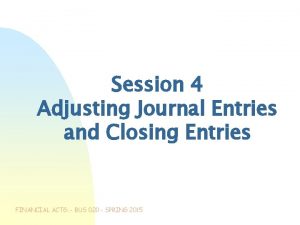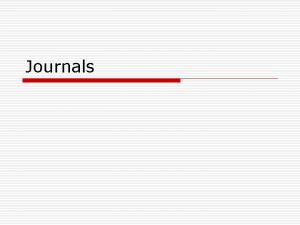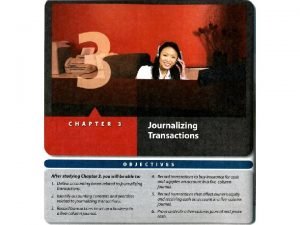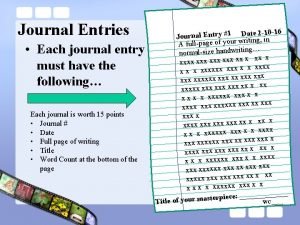Journals Source Documents Recording Entries in a Journal




































- Slides: 36

Journals, Source Documents, & Recording Entries in a Journal Chapter Three

Chapter Introduction After taking chapter 2 test, list all new vocabulary words for chapter 3 and write out their definitions. • Journalizing • Special Amount Columns • General Amount Columns • Entry • Double-entry accounting • • Source document Check Invoice Sales invoice Receipt Memorandum Proving Cash

Journals and Journalizing • Journal: form for recording transactions in chronological order. • Recording transaction in a journal is called journalizing. – Journal is permanent record – Fits the needs of the business • What determines the kind of journal used? – Nature of business – Number of transactions • Journalizing is done daily!

Five-Column Journal Five Amount Columns – General Debit – General Credit – Sales Credit – Cash Debit – Cash Credit Special Amount Column: a journal amount column headed with an account title. • Used for frequently occurring transactions • Eliminates writing an account title in the Account Title column and saves time Three Special Amount Columns: • Sales Credit • Cash Debit • Cash Credit

Five Column Journal General Amount Column: a journal amount column that is not headed with an account title. • General Debit • General Credit Facts about the Journal • Information recorded includes debit and credit parts of each transaction in one location. • Data can be verified by comparing journal to transaction data. • Transactions are recorded in chronological order.

Journalizing Entry: information for each transaction recorded in a journal. Double-entry accounting: recording of debit and credit parts of a transaction. • Each transaction affects at least two accounts • A debit and a credit are recorded • Debits = Credits

Source Documents are business papers from which information is obtained for a journal entry. – – Each transaction is described by a source document that proves it occurred. Example: Check stub for each cash payment Objective Evidence: applied when a source document is prepared for each transaction.

Five Source Documents • • • Checks Sales Invoices Receipts Calculator Tapes Memorandums

Source Documents • Checks (Source document for cash payments) • Sales Invoices (Source document for recording a sale on a account) – Invoice: form describing the goods or services sold, the quantity, and the price. • Receipts – written acknowledgement for cash received (Source document for cash received from sources other than sales) – Example: Received Cash and an Investment – Calculator Tapes (Cash Sales) • Memorandums – a form for which a brief message is written describing a transaction. (Used when no other source document is prepared for a transaction or when an additional explanation is needed.

Journal Entries A Journal entry consists of four parts: • Date • Debit • Credit • Source Document Use T accounts to help you!

Journal Entry Examples Received Cash From Owner as an Investment, $5, 000. Receipt No. 1 FYI – Dollar and cent signs, decimals are not used when writing on ruled paper

Journal Entry Example August 3 -Paid Cash for Supplies, $275. 00. Check No. 1 Remember: Writing Cash frequently could be time consuming- Special amount columns are used for these frequently used accounts

Review 1. In what order are transactions recorded in a journal? 2. Why are source documents important? 3. List the four parts of a journal entry.

Practice • Working Together • On Your Own • Application Problem 3 -1

Review Look under your chairs – you may have a slip of paper 1. Read Your Question 2. Give the Answer 3. Prize Go Over Application Problem 31

Section 3 -2: Journalizing August 4 th – Paid Cash for Insurance, $1200. Check No. 2

Bought Supplies on Account August 7 - Bought Supplies on Account from Supply Depot, $500. Memorandum No. 1

Paid Cash on Account August 11 – Paid Cash on Account to Supply Depot, $300. Check No. 3

Practice Working Together On Your Own

Journalizing Transaction that affect OE and Receiving Cash on Account August 12 – Received Cash from Sales, $295. Tape No. 12

Sold Service on Account August 12 – Sold services on account to Oakdale School, $350. Sales Invoice No. 1

Paid Cash for an Expense August 12 – Paid Cash for Rent, $300. Check No. 4

Received Cash on Account August 12 – Received cash on account from Oakdale School, $200. Receipt No. 2

Paid Cash to Owner for Personal Use August 12 – Paid cash to owner for personal use, $125. Check No. 6

Practice and Reviewing Section 3 • Working Together • On Your Own Section 2 -3 • Audit Your Understanding p. 66 & 72 Homework Application Problems 3 -2 and 3 -3

Review Quiz 1. In what order are transactions recorded in a journal? 2. What are the four parts of a journal entry? 3. Why are source documents important? 4. What are three special account columns? 5. What columns are used to record Received Cash from owner as investment?

Section 3 -4: Proving and Ruling a Journal When all but the last line on a journal page is used, columns are proved and ruled…. • Total are carried forward to the next page Steps in Proving a Journal: 1. Add each amount column 2. Add Debit column totals, Add Credit Column totals 3. Verify that Total Debits=Total Credit • • Journal page is PROVED If errors- must correct first

Steps in Ruling a Journal Page You Must Use a STRAIGHT EDGE! • Rule single line across all amount columns – indicated that columns are to be totaled • On the next line, write date • Write Carried Forward in the Account Title column – checkmark placed on post ref. column • Write in column totals • Rule double line below totals – Indicates amounts are totals and debit=credits

Starting a NEW JOURNAL Page • Write page number at top • Write date (year, month and day) • Write Brought Forward – check mark is placed in the post ref. column • Record column totals from previous page

Proving and Ruling at the End of the Month • Rule single line to indicate columns will be added • Write date • Write the word Totals in the account title column – check mark is NOT placed in the post ref. • Write each column total • Rule double line debits=credits

Proving Cash Determining that the amount of cash agrees with accounting records… 1. Add Cash at beginning and Cash Debit Column 2. Subtract Cash paid out- Cash Credit column 3. This equal cash balance at the end of the month 4. Compare to checkbook balance – next unused check stub.

Practice • Section 2 -4 – Working Together – On Your Own – Application 4 • Work on Application Problems 5

Review • Quotes/ Brainteasers • Audit Test • Go over Homework

Standard Accounting Practice Procedures for error corrections, abbreviated words, signs and rulings. • Popcorn reading • Write on the board • Students make a list

Practice & Application • Crossword Puzzle • Applications Problems 6 -6 • Homework 6 -7

Review • • • Catch Phrase Study Guide Review Game Audit Test Chapter Three Test
 Account closing
Account closing Accounting 1 chapter 8 study guide
Accounting 1 chapter 8 study guide Hamlet journal
Hamlet journal Entries for payroll and payroll taxes
Entries for payroll and payroll taxes Warranty journal entries
Warranty journal entries To kill a mockingbird journal entries by chapter
To kill a mockingbird journal entries by chapter Call of the sea chapter 3 journal entries
Call of the sea chapter 3 journal entries Intercompany profit transactions inventories
Intercompany profit transactions inventories Secured borrowing journal entries
Secured borrowing journal entries Problem 7-1 opening ledger accounts
Problem 7-1 opening ledger accounts Lewis and clark journal entries
Lewis and clark journal entries Sole proprietorship journal entries
Sole proprietorship journal entries Equity method accounting journal entries
Equity method accounting journal entries Fac3704
Fac3704 Adjusting and closing entries
Adjusting and closing entries The great gatsby journal entries chapter 1
The great gatsby journal entries chapter 1 Writing prompts for the great gatsby
Writing prompts for the great gatsby Accrued revenue adjusting entry
Accrued revenue adjusting entry Writers in long beach california
Writers in long beach california What are the 8 branches of accounting?
What are the 8 branches of accounting? Medieval journal entries
Medieval journal entries Closing entries
Closing entries Appretaite
Appretaite Equity journal entries examples
Equity journal entries examples The greasers and socs venn diagram answers
The greasers and socs venn diagram answers Short working in royalty accounts means
Short working in royalty accounts means Romeo and juliet journal entries
Romeo and juliet journal entries Journal entry stock dividend
Journal entry stock dividend Contoh journal entries
Contoh journal entries Accrued and prepaid expenses
Accrued and prepaid expenses Periodic and perpetual inventory system
Periodic and perpetual inventory system Installment liquidation meaning
Installment liquidation meaning Intercompany inventory transactions
Intercompany inventory transactions Lkas 17 in sinhala medium
Lkas 17 in sinhala medium Features of hire purchase ppt
Features of hire purchase ppt Post entries to ledger account
Post entries to ledger account Amalgamation journal entries
Amalgamation journal entries
